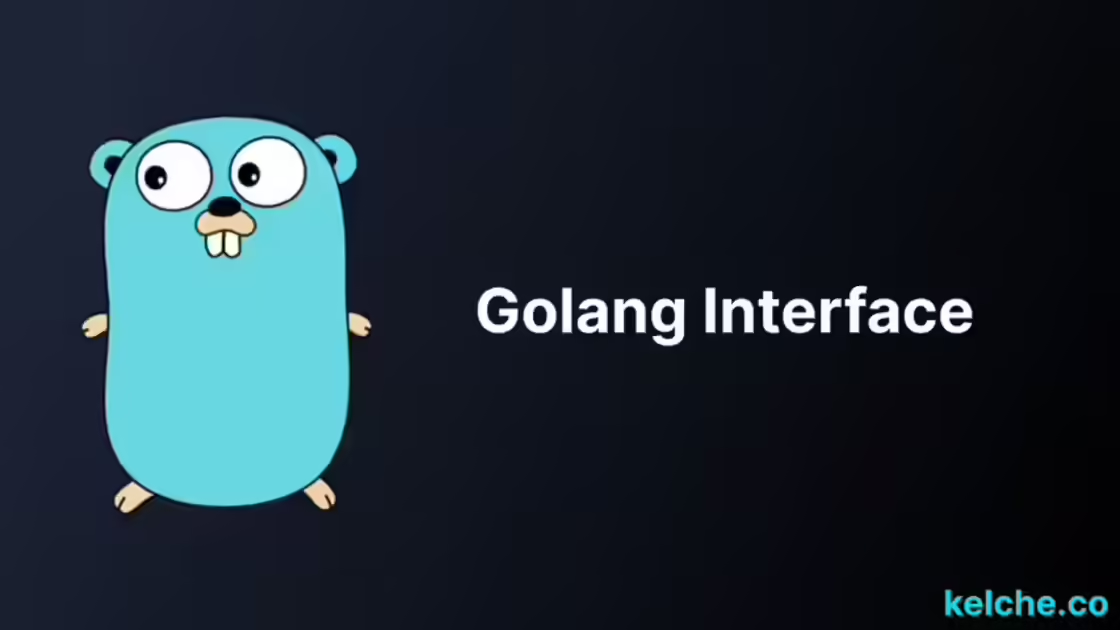Golang Interfaces Demystified: A Complete Handbook
What is an Interface in Go?
An interface is a set of methods that a type must implement. In other words, an interface is a contract that a type must follow. If a type implements all the methods of an interface, then it is said to implement the interface.
Interfaces provide an object-oriented approach in Go ( Polymorphism ), though Go is not an object-oriented language.
How to Declare an Interface in Go
An interface is declared using the interface keyword. The syntax for declaring an interface is as follows:
type <interface_name> interface {
<method_name_1>(<parameters>) <return_type>
<method_name_2>(<parameters>) <return_type>
...
}
Let’s take a look at an example:
type Shape interface {
Area() float64
Perimeter() float64
}
In the above example, we have declared an interface named Shape. The Shape interface has two methods: Area and Perimeter. The Area method takes no parameters and returns a float64 value. Similarly, the Perimeter method takes no parameters and returns a float64 value.
How to Implement an Interface in Go
A type implements an interface by implementing all the methods of the interface. The syntax for implementing an interface is as follows:
type <type_name> struct {
<field_name_1> <field_type_1>
<field_name_2> <field_type_2>
...
}
func (<receiver_name> <type_name>) <method_name_1>(<parameters>) <return_type> {
...
}
func (<receiver_name> <type_name>) <method_name_2>(<parameters>) <return_type> {
...
}
...
Let’s take a look at an example:
package main
import "fmt"
type Book struct {
title string
author string
price float64
}
type Drink struct {
name string
price float64
}
type Printer interface {
printIt()
}
func (b Book) printIt() {
fmt.Printf("Book: %s by %s costs $%.2f\n", b.title, b.author, b.price)
}
func (d Drink) printIt() {
fmt.Printf("%s costs $%.2f\n", d.name, d.price)
}
func main() {
b1 := Book{
title: "The Alchemist",
author: "Paulo Coelho",
price: 8.99,
}
d1 := Drink{
name: "Coke",
price: 1.99,
}
info := []Printer{b1, d1}
for _, v := range info {
v.printIt()
}
}
Output:
Book: The Alchemist by Paulo Coelho costs $8.99
Coke costs $1.99
A lot is going on in the above example. Let’s break it down.
First, we have declared two types: Book and Drink. Both types have a price field. The Book type has two more fields: title and author. The Drink type has a name field. Both types have a printIt method. The printIt method takes no parameters and returns nothing.
Next, we have declared an interface named Printer. The Printer interface has a printIt method. The printIt method takes no parameters and returns nothing. The printIt method is implemented by both the Book and Drink types.
Finally, we have a main function. In the main function, we have created two values of type Book and Drink. We have created a slice of type Printer and added the two values to the slice. We have then iterated over the slice and called the printIt method on each value. The printIt method is called on the value of type Book and the value of type Drink.
If we added a new type to the Printer interface, we would have to implement the printIt method on the new type as well. Also by introducing a foreign type to the info slice, we would have to implement the printIt method on the foreign type as well, or else we would get a compile-time error.
There is no explicit declaration of intent and no implements keyword. If a
type provides all the methods required by an interface, it is said to
implement the interface.
How to Use an Interface as a Type in Go
An interface can be used as a type. The syntax for using an interface as a type is as follows:
...
var <variable_name> <interface_name>
Let’s take a look at an example:
type Printer interface {
printIt()
}
type MyPrinter struct {
}
func (p *MyPrinter) printIt() {
println("printIt")
}
func main() {
var p Printer = &MyPrinter{}
p.printIt()
}
Output:
printIt
In the above example, we have declared an interface named Printer. The Printer interface has a printIt method. The printIt method is implemented by the MyPrinter type. The MyPrinter type has a printIt method.
We have declared a variable named p of type Printer. We have assigned a value of type MyPrinter to the p variable. We have then called the printIt method on the p variable. The printIt method is called on the value of type MyPrinter.
Empty Interface in Go
An empty interface is an interface that has no methods. The syntax for declaring an empty interface is as follows:
...
interface {}
Let’s take a look at an example:
...
func main() {
var i interface{}
i = 10
fmt.Println(i)
i = "Hello"
fmt.Println(i)
i = true
fmt.Println(i)
}
An empty interface can hold any type of value. In the above example, we have declared a variable named i of type interface{}. We have assigned a value of type int, string, and bool to the i variable. We have then printed the value of the i variable. The value of the i variable is printed as 10, Hello and true respectively.
This is important in cases where we don’t know the type of value that we are working with.
Type Assertion in Interfaces in Go
Type assertion is a way to check the type of a value. The syntax for type assertion is as follows:
//...
<value>.(type)
Assertion can be done in two ways:
- Simple assertion
func main() {
var i interface{} = "Hello"
s := i.(string)
fmt.Println(s)
f := i.(float64) // panic
fmt.Println(f)
}
Output:
Hello
panic: interface conversion: interface {} is string, not float64
...
- Comma ok assertion
This is a safer way to assert the type of value because it doesn’t panic if the type assertion fails.
func main() {
var i interface{} = "Hello"
s, ok := i.(string)
fmt.Println(s, ok)
f, ok := i.(float64)
fmt.Println(f, ok)
}
Output:
Hello true
0 false
In the above example, we have declared a variable named i of type interface{}. We have assigned a value of type string to the i variable. We have then asserted the type of the i variable. The type of the i variable is asserted using the simple assertion. The type of the i variable is asserted using the comma ok assertion.
Type Switch in Interfaces in Go
A type switch is a way to check the type of a value. The syntax for the type switch is as follows:
//...
switch <value>.(type) {
case <type1>:
//...
case <type2>:
//...
default:
//...
}
Type switch is important when dealing with an empty interface. Let’s take a look at an example:
func do(i interface{}) {
switch v := i.(type) {
case int:
fmt.Printf("Twice %v is %v \n", v, v*2)
case string:
fmt.Printf("%q is %v bytes long \n", v, len(v))
default:
fmt.Printf("I don't know about type %T! \n", v)
}
}
func main() {
do(21)
do("hello")
do(true)
}
Output:
Twice 21 is 42
"hello" is 5 bytes long
I don't know about type bool!
In the above example, we declare the function do which takes an empty interface as a parameter. The function do uses a type switch to check the type of the value passed to it. The function do prints the value of the value passed to it. We have called the do function with three different types of values. The do function is called with a value of type int, string, and bool. The do function prints the value of the value passed to it.
Interfaces in variadic functions in Go
Interfaces can be used in variadic functions. Let’s take a look at an example:
type Printer interface {
printIt()
}
type Book struct {
name string
}
func (b *Book) printIt() {
fmt.Println(b.name)
}
type Drink struct {
name string
}
func (d *Drink) printIt() {
fmt.Println(d.name)
}
func printAll(printers ...Printer) {
for _, p := range printers {
p.printIt()
}
}
func main() {
book := &Book{name: "The Alchemist"}
drink := &Drink{name: "Coke"}
printAll(book, drink)
}
Output:
The Alchemist
Coke
The printAll function takes a variadic parameter of type Printer. The printAll function iterates over the printers slice and calls the printIt method on each value of the printers slice. The printAll function is called with two values of type Book and Drink. The printAll function prints the name of the Book and Drink.
You can complement variadic functions with interface and switch statements to create a powerful tool for handling different types of data.
Multiple Interfaces in a struct in Go
A struct can implement multiple interfaces. Let’s take a look at an example:
...
type Printer interface {
printIt()
}
type Scanner interface {
scanIt()
}
type MyPrinterScanner struct {
name string
}
func (m *MyPrinterScanner) printIt() {
fmt.Println(m.name)
}
func (m *MyPrinterScanner) scanIt() {
fmt.Println(m.name)
}
func main() {
var p Printer = &MyPrinterScanner{name: "MyPrinterScanner"}
p.printIt()
var s Scanner = &MyPrinterScanner{name: "MyPrinterScanner"}
s.scanIt()
}
Output:
MyPrinterScanner
MyPrinterScanner
The MyPrinterScanner struct implements both the Printer and Scanner interfaces. The MyPrinterScanner struct has a method named printIt which implements the Printer interface. The MyPrinterScanner struct has a method named scanIt which implements the Scanner interface. The MyPrinterScanner struct is assigned to a variable of type Printer and a variable of type Scanner. The printIt method is called on the Printer variable. The scanIt method is called on the Scanner variable.
Embeding Interfaces in Go
Golang does not allow multiple inheritance. However, it does allow the embedding of interfaces. This is by merging the methods of two or more interfaces into a single interface. Let’s take a look at an example:
...
type Printer interface {
printIt()
}
type Scanner interface {
scanIt()
}
type PrinterScanner interface {
Printer
Scanner
}
type MyPrinterScanner struct {
name string
}
func (m *MyPrinterScanner) printIt() {
fmt.Println(m.name)
}
func (m *MyPrinterScanner) scanIt() {
fmt.Println(m.name)
}
func main() {
var p PrinterScanner = &MyPrinterScanner{name: "MyPrinterScanner"}
p.printIt()
p.scanIt()
}
Output:
MyPrinterScanner
MyPrinterScanner
In the above example, we have declared two interfaces named Printer and Scanner. We have then declared an interface named PrinterScanner which embeds the Printer and Scanner interfaces. We later declared a struct MyPrinterScanner which implements the PrinterScanner interface. Finally, we have called the printIt and scanIt methods on p which is of type PrinterScanner.
Tldr
Interfaces introduce the concept of polymorphism in Go. Interfaces are declared using the interface keyword. Interfaces are implemented by structs. A struct implements an interface by implementing all the methods of the interface. A struct can implement multiple interfaces. An interface can be embedded in another interface. Interfaces can be used in variadic functions. Interfaces can be used in type switches. Interfaces can be used in type assertions.

